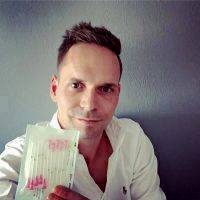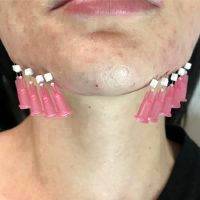Thread Facelift Side Effects
The most common side effects from thread facelifts are small swelling, bruising and pain when touching.
However, sometimes more serious side effects occur, such as scarring around the threads, creasing and wrinkling, infection in the place of the threads, jaggies on the threads become visible or protruding outward, as well as the need for a repeat operation. For more information on the side effects, see below.
Threads Facelift refers to non-surgical methods of rejuvenation. The technique has been known for more than 15 years and is successfully used in various countries of the world.
Cosmetic threads are advisable to apply in those cases when conventional cosmetic procedures no longer give the proper result for correcting age-related changes.
Typically, this method is chosen by those women who can not yet decide on a serious plastic surgery, and gentle methods – biorevitalization, mesotherapy, laser resurfacing and the like no longer have an effect.
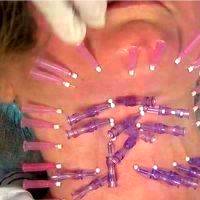
A Thread Lift Is A Type Of Face Lift
Types of threads for facelift
Reviews of threads for a facelift. The use of threads allows to tighten sagging areas of the skin and increase its elasticity, smooth wrinkles, make the outline of the face more clear.
Depending on the result, which you want to get, the features of the face and the degree of expression of age-related changes in the patient, cosmetologists and plastic surgeons use different types of threads. There are a lot of these types, but the following are most often used:
Smooth (Tissulift).
They consist of interwoven fibers of silicone, polyamide and polyurethane. Surface of surgical threads for facelift is even, threads are not exposed to resorption.
They are located in the form of a loop in the deep layers of the skin, fixing them on the bone tissue, so they provide a qualitative pull-up even with a strong sagging of the tissues. The method involves carrying out incisions under local or, in some cases, general anesthesia, so it is usually performed under operating conditions.
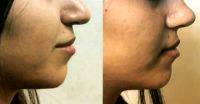
Facelift With Threads Before And After Pic
Thread-lifting (3D threads)
The thinnest among the resorbable threads for lifting, they are usually injected with a blunt cannula that does not pierce, but spreads the tissue.
Therefore, the technique is the least traumatic, but it requires from the doctor accuracy of movements and special professionalism. Wrong movements can lead to tugging of the skin and deformation of facial features.
The threads dissolve in the skin after six months, but during this time a collagen “skeleton” is created in their place, which provides a supporting effect (for many doctors this statement provokes only a skeptical smirk) for about two years. But still the result of their use is the most sparing, therefore they are not suitable for people with strong age-related changes. Applied at the first signs of aging or as its prevention – which is more like the truth – in patients 30-40 years old.
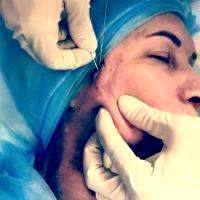
Facelifting Threads Photo
Aptos Threads
Their peculiarity is the presence of barbs, which help the threads to gain a foothold in the tissues, clinging like hooks. The thread is inserted into the subcutaneous layer to a depth of 3-5 mm by means of a microscopic puncture.
Several types of Aptos threads have been developed for tightening different parts of the face (for example, “hammock” strings for correcting the second chin or “spring” for the cheeks and nasolabial folds).
Recovery period lasts about 2 weeks, during the month it is recommended to restrain active facial expressions. As in the case of other types of threads facelift, the introduction of Aptos threads should be trusted only by professionals.
My cosmetician says that she is afraid to use these threads to her patients precisely because of the long time of resorption of them inside the body. Like, one thing, when the accidental negative effect of an unsuccessful introduction will last a year, and another four!
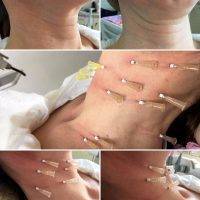
The Lunch Hour Lift Photo
Cone-shaped combined threads (Silhouette Soft)
They have nodules and cones, and thanks to them they are fixed in tissues in the right places. The sutures and cones are made from a component called Polylactic Acid (PLA) which has been used by doctors and surgeons for many years.
They are used for correction of face contour, skin tightening. The disadvantages of these threads are the tubercles, which can protrude in the region of the temples, where nodules are attached.
The recovery is about two weeks, during this period there is swelling of the face. For a month it is not recommended to smile, laugh, make faces. The cost of this technique starts from $1,750.
The price depends on the number of used threads and correction tasks. A facelift by this method is best performed for women under the age of 50, since with strong sagging of the skin, it may not be very effective.
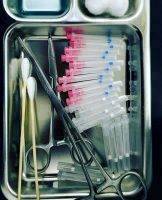
Thread Facelift Instruments
How is the thread facelift performed?
The procedure is quite painful, therefore, before the beginning of the operation, local or infiltration anesthesia (lidocaine, ultracaine) is administered, which is injected into the sites of the supposed punctures. In the process of surgical intervention, the needle is inserted through a puncture or a small incision under the skin with a special needle.
As a rule, threads have bards or knots, due to which it is possible to fix soft tissues and create a new skeleton, providing the effect of tightening and smoothing the skin.
The operation will take from 20 to 30 minutes. The effect of using threads can be compared with the result of plastic surgery. The recovery period is about 1-2 weeks, in rare cases 1 month.
The recovery period depends on the age of the patient, the tissue healing, the correctness of care, the qualification of the specialist and the quality of the correction done and the threads used, and the hygiene rules. At first, there is swelling of the face and painfull of the soft tissues. Anesthetic drugs are prescribed to reduce pain.
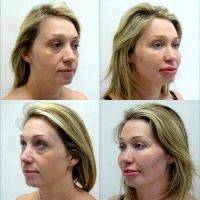
Thread Lift Facelift Before And After Photo
Complications, side effects, result.
The result of the performed procedure for the facelift with the use of threads is maintained for 1.5-5 years.
Side effects and complications include:
- Hematomas;
- Edema;
- Painful sensations;
- Whitening of the site due to decreased blood supply;
- nodule or a notch, the thread edge could puncture the skin;
- Unnaturalness of the facelift (lines of the thread are visible to the naked eye);
- Asymmetry caused by non-uniform introduction of threads;
- Allergic reaction and individual intolerance to anesthesia.
With the help of threads facelift, the following results can be achieved:
- Reduction of flabbiness of the skin;
- Smoothing out pronounced wrinkles and folds;
- Correction of the facial contours;
- Slowing of aging.
Complications after the procedure.
In spite of the fact, that the facelift by the threads is not very low traumatic, after this procedure complications are also possible:
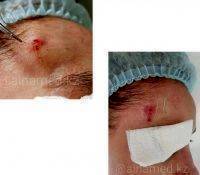
Threading Face Lift Side Effects Picture
- The ends of the threads must be removed, since they are exposed;
- Failures of threads (if the recommendations of the doctor are not implemented);
- Edema, bruising and subcutaneous hemorrhage;
- Infection;
- Pretty strong post-operative pain;
- Weakening of threads, which requires correction.
- An additional facelift is performed after 3 months.
Recovery period
You will need to restore a few days. In rare cases, this period lasts up to 1.5 weeks. At this time there is observed:
- Some skin, which gradually straightened and visual bumps along the threads disappear;
- Small hematomas (especially in women who smoke because of the fragility of the walls of blood vessels). They are also within a few days pass;
- Soreness, which can be removed with the help of prescribed medications;
- The feeling of tightness of the skin.
No postoperative procedures, compression dressings are provided. Sharp facial movements and massage for two to three weeks are contraindicated.
At this time, cosmetic procedures are also prohibited.
How do I fix errors? Is it possible to do something if the threads are not positioned correctly? The most radical way to correct errors in this case is to remove the threads. But. Experienced surgeons can find an alternative if required:
- Trim the nodules (if they become visible);
- Tighten the threads (if they become sagging);
- The face lost weight and the ptosis of tissues increased.
For resorbable threads, physicians can prescribe physiotherapy procedures that promote rapid biodegradation of the threads.
Perhaps, the doctor-dermatocosmetologist will recommend additional procedures for botulinum therapy or contour plastic surgery to visually correct the skin relief.Indications and contraindications
You can think about the possibility of installing threads if you have:
- Ptosis of the outer edge of the eyebrows;
- Gravitational ptosis of the facial contours, flew;
- Deep nasolabial folds, creases;
- Nasolocular furrows and folds;
- Wrinkles on the face, neck, and also on the chest and buttocks.
The thread lifts are contraindicated for people with:
- Dermal diseases in the intended area of introduction of the filaments;
- Infectious diseases in acute stage: influenza, SARS, herpes, etc .;
- Oncology, including benign;
- Diseases of blood associated with increased thrombosis.
Thread facelift is a minimally invasive procedure and excellent alternative to traditional face and body plastic surgeries.
